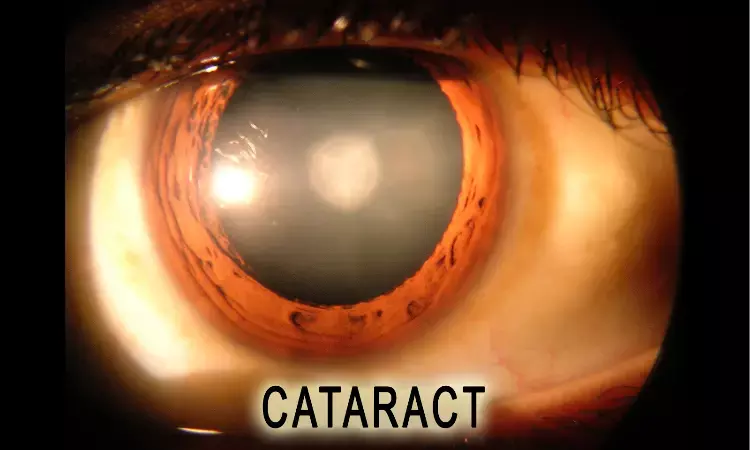- Home
- Medical news & Guidelines
- Anesthesiology
- Cardiology and CTVS
- Critical Care
- Dentistry
- Dermatology
- Diabetes and Endocrinology
- ENT
- Gastroenterology
- Medicine
- Nephrology
- Neurology
- Obstretics-Gynaecology
- Oncology
- Ophthalmology
- Orthopaedics
- Pediatrics-Neonatology
- Psychiatry
- Pulmonology
- Radiology
- Surgery
- Urology
- Laboratory Medicine
- Diet
- Nursing
- Paramedical
- Physiotherapy
- Health news
- Fact Check
- Bone Health Fact Check
- Brain Health Fact Check
- Cancer Related Fact Check
- Child Care Fact Check
- Dental and oral health fact check
- Diabetes and metabolic health fact check
- Diet and Nutrition Fact Check
- Eye and ENT Care Fact Check
- Fitness fact check
- Gut health fact check
- Heart health fact check
- Kidney health fact check
- Medical education fact check
- Men's health fact check
- Respiratory fact check
- Skin and hair care fact check
- Vaccine and Immunization fact check
- Women's health fact check
- AYUSH
- State News
- Andaman and Nicobar Islands
- Andhra Pradesh
- Arunachal Pradesh
- Assam
- Bihar
- Chandigarh
- Chattisgarh
- Dadra and Nagar Haveli
- Daman and Diu
- Delhi
- Goa
- Gujarat
- Haryana
- Himachal Pradesh
- Jammu & Kashmir
- Jharkhand
- Karnataka
- Kerala
- Ladakh
- Lakshadweep
- Madhya Pradesh
- Maharashtra
- Manipur
- Meghalaya
- Mizoram
- Nagaland
- Odisha
- Puducherry
- Punjab
- Rajasthan
- Sikkim
- Tamil Nadu
- Telangana
- Tripura
- Uttar Pradesh
- Uttrakhand
- West Bengal
- Medical Education
- Industry
Phaco chop and drill‐and‐crack equally effective for phacoemulsification of hard cataracts: Study

According to a recent research, it has been observed that the phaco chop and drill‐and‐crack techniques are equally effective for disassembly of hard NO4 and NO5 cataracts, as published in the Journal of Acta Ophthalmologica .
The complete disassembly of nuclear is the most challenging step in hard cataract surgery through microincision. Phaco chop is a bimanual phacoemulsification technique to remove cataracts. Studies have shown that compared with four-quadrant 'divide and conquer', the phaco chop technique uses less phaco time and energy, significantly reducing endothelial cell damage. Other advantages of phaco chop include reduction of zonular and capsular stress because forces are directed toward an opposing instrument and the phaco tip is kept in a central 'safe zone' in the middle of the pupil. This technique has also been successfully adapted to the canine phacoemulsification procedure.
However, the the drill-and-crack technique, which combines phaco chop and the prechopper, makes a deep hole (drill) in the central nucleus with the phaco tip and divides the nucleus (crack) with the prechopper inside the hole.
Hence, Hazem Abdelmotaal and colleagues from the Department of Ophthalmology, Faculty of medicine, Assiut University, Assiut, Egypt decided to quantify the intraoperative parameters and postoperative outcomes after using the phaco chop technique in one eye and drill‐and‐crack technique in the other eye in patients with bilateral dense brunescent cataract.
The authors used the Lens Opacities Classification System III grading system to select 132 eyes of 66 patients with bilateral nuclear opalescence (NO) grade NO4 or grade NO5. One eye in each patient with bilateral dense brunescent cataract was subjected to phacoemulsification using the phaco chop technique, while the other eye was subjected to phacoemulsification with the drill‐and‐crack technique for nucleus disassembly. The intraoperative parameters were quantified. Surgical outcome was assessed preoperatively and 1 day, 4 weeks and 12 weeks postoperatively, and the outcomes of the two techniques were compared.
The following results were obtained-
a. There was no significant difference between the techniques in operative parameters [cumulative dissipated energy (p = 0.74), surgical time (p = 0.68) or surgical difficulty during nucleus disassembly (p = 0.80)].
b. There was no significant difference in the postoperative change in central corneal thickness between the techniques at day 1, 4 weeks and 12 weeks or in corneal endothelial cell density loss at 4 and 12 weeks (p > 0.05).
c. There was no significant difference between the techniques in the mean corrected distance visual acuity (logarithm of the minimum angle resolution) at 4 weeks postoperatively (p = 0.25).
Therefore, the authors concluded that "the phaco chop and drill‐and‐crack techniques are equally effective for disassembly of hard NO4 and NO5 cataracts."
Dr. Nandita Mohan is a practicing pediatric dentist with more than 5 years of clinical work experience. Along with this, she is equally interested in keeping herself up to date about the latest developments in the field of medicine and dentistry which is the driving force for her to be in association with Medical Dialogues. She also has her name attached with many publications; both national and international. She has pursued her BDS from Rajiv Gandhi University of Health Sciences, Bangalore and later went to enter her dream specialty (MDS) in the Department of Pedodontics and Preventive Dentistry from Pt. B.D. Sharma University of Health Sciences. Through all the years of experience, her core interest in learning something new has never stopped. She can be contacted at editorial@medicaldialogues.in. Contact no. 011-43720751
Dr Kamal Kant Kohli-MBBS, DTCD- a chest specialist with more than 30 years of practice and a flair for writing clinical articles, Dr Kamal Kant Kohli joined Medical Dialogues as a Chief Editor of Medical News. Besides writing articles, as an editor, he proofreads and verifies all the medical content published on Medical Dialogues including those coming from journals, studies,medical conferences,guidelines etc. Email: drkohli@medicaldialogues.in. Contact no. 011-43720751


